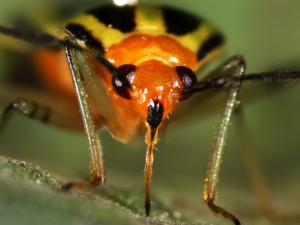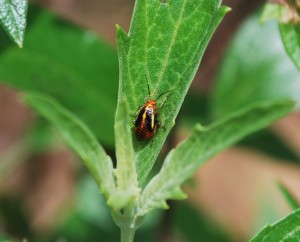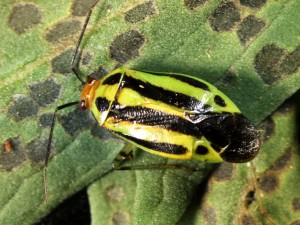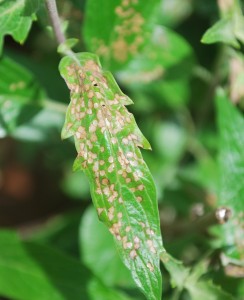Four-lined plant bugs are tearing up in the home landscape this week. This true bug feeds on more than 250 mostly herbaceous and small woody ornamental plants. Like Jack Reacher, they are alert, quick, and difficult to detect.
Eggs of the four-lined plant bug overwinter in tender shoots and plant debris. After hatching, the nymphs begin feeding on succulent plant tissues by late-May. Adult four-lined plant bugs are small (3/16th of an inch) and yellow with 4 longitudinal stripes (good name) down their backs. The nymphs are smaller with black and yellow striped wing pads.
In May and June, look in the canopies of susceptible plants for the bugs and their feeding symptoms. These insects are small and hard to find, so sweep net sampling is best for these elusive creatures. Four-lined plant bugs feed by sucking plant sap. Feeding results in clusters of brown to- black round spots. The spots may coalesce to distort or damage entire leaves. A few bugs will do considerable damage, but there are no reports of these critters killing any plants. Feeding stops by late-June and most plants will simply outgrow the damage, so treatments are usually unnecessary.
If, however, the feeding damage is objectionable on a high value landscape, then there are a number of effective insecticide choices. Sweep the foliage beginning in May to detect the feeding insects. If emerging nymphs are detected, make applications of an insecticidal oil. If the canopy is dense, consider using a foliar absorbed material or use a soil drench with a systemic insecticide. The following materials are labeled for this pest: acetamiprid, bifenthrin, bifenthrin+imidacloprid, carbaryl, clothianidin, cyfluthrin, deltamethrin, horticultural oil, insecticidal soap, lambda-cyhalothrin, malathion, and permethrin.





